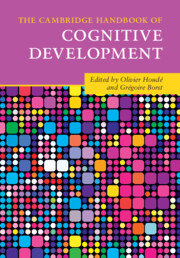Book contents
- The Cambridge Handbook of Cognitive Development
- The Cambridge Handbook of Cognitive Development
- Copyright page
- Contents
- Figures
- Tables
- Contributors
- Introduction
- Part I Neurobiological Constraints and Laws of Cognitive Development
- 1 How Life Regulation and Feelings Motivate the Cultural Mind
- 2 Epigenesis, Synapse Selection, Cultural Imprints, and Human Brain Development
- 3 Mapping the Human Brain from the Prenatal Period to Infancy Using 3D Magnetic Resonance Imaging
- 4 Development and Maturation of the Human Brain, from Infancy to Adolescence
- 5 Genetic and Experiential Factors in Brain Development
- 6 The Brain Basis Underlying the Transition from Adolescence to Adulthood
- Part II Fundamentals of Cognitive Development from Infancy to Adolescence and Young Adulthood
- Part III Education and School-Learning Domains
- Index
- Plate Section (PDF Only)
- References
6 - The Brain Basis Underlying the Transition from Adolescence to Adulthood
from Part I - Neurobiological Constraints and Laws of Cognitive Development
Published online by Cambridge University Press: 24 February 2022
- The Cambridge Handbook of Cognitive Development
- The Cambridge Handbook of Cognitive Development
- Copyright page
- Contents
- Figures
- Tables
- Contributors
- Introduction
- Part I Neurobiological Constraints and Laws of Cognitive Development
- 1 How Life Regulation and Feelings Motivate the Cultural Mind
- 2 Epigenesis, Synapse Selection, Cultural Imprints, and Human Brain Development
- 3 Mapping the Human Brain from the Prenatal Period to Infancy Using 3D Magnetic Resonance Imaging
- 4 Development and Maturation of the Human Brain, from Infancy to Adolescence
- 5 Genetic and Experiential Factors in Brain Development
- 6 The Brain Basis Underlying the Transition from Adolescence to Adulthood
- Part II Fundamentals of Cognitive Development from Infancy to Adolescence and Young Adulthood
- Part III Education and School-Learning Domains
- Index
- Plate Section (PDF Only)
- References
Summary
Adolescence is primarily characterized by puberty (Vijayakumar et al., 2018) which demarcates sexual maturation that can start as young as 10–12 years of age (Parent et al., 2003) and proceeds until adult independence, which may continue until the mid-twenties (National Research Council, 2013). Adolescence is characterized as a time of a peak in sensation seeking (Chambers et al., 2003; Spear, 2000), the drive to explore novel experiences that generate increased sensations, despite possible long-term negative consequences (Zuckerman, 2008). While sensation seeking can be adaptive, including information seeking and exploration, to gain new experiences needed to optimally develop into an independent adult, it can also lead to risk-taking behavior, due to decision-making processes that weigh short-term rewards over long-term risks to survival. In fact, adolescents in the United States experience a four-fold increase in deaths over US adults due to risk-taking behaviors (e.g., crime, substance use, reckless driving) (Eaton et al., 2012). Thus, adolescents are often believed to lack forethought and behave in volatile and unpredictable ways. Adolescent peaks in sensation seeking, however, are present across species (Hodes & Shors, 2005; Stansfield & Kirstein, 2006) and across cultures (Steinberg et al., 2018), underscoring their adaptive nature. Adolescence is also a time for vulnerability to the emergence of psychopathology such as schizophrenia, mood disorders, anxiety, suicidality, and addiction (Paus et al., 2008). This adolescent vulnerability for emergence of psychopathology suggests that maturational processes unique to this period may impair development and/or reveal impairments that are present but unseen until puberty, becoming apparent as the brain transitions through adolescence and into adulthood. Thus, there is great interest in understanding the neurobiological mechanisms that underlie normative development to identify brain processes that may contribute to impaired development in adolescence.
Information
- Type
- Chapter
- Information
- The Cambridge Handbook of Cognitive Development , pp. 122 - 138Publisher: Cambridge University PressPrint publication year: 2022
References
Accessibility standard: Unknown
Why this information is here
This section outlines the accessibility features of this content - including support for screen readers, full keyboard navigation and high-contrast display options. This may not be relevant for you.Accessibility Information
- 1
- Cited by
